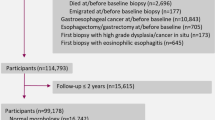Abstract
Background
Barrett’s metaplasia is the predominant precursor for the development of esophageal adenocarcinoma. This precancerous lesion has become the focus of various surveillance programs aimed at detecting earlier and therefore potentially curable lesions. However, sampling error by missing invasive cancer lesions is a common problem. This study aimed to identify preferred locations within a segment of Barrett’s mucosa for the development of esophageal adenocarcinoma.
Methods
The study group consisted of 213 patients with histologically proven esophageal adenocarcinoma. Of those, there were 134 cases of early cancer and 79 cases of locally advanced lesions. These patients received neoadjuvant chemotherapy. The frequency of intestinal metaplasia and the location of the tumor occurrence within the segment of intestinal metaplasia were assessed.
Results
Intestinal metaplasia was found in 83% of the early lesions and in 98% of the advanced tumors after neoadjuvant chemotherapy. In 82.2% of the cases, the tumor was located at the distal margin of the intestinal metaplasia in patients with early tumor manifestations. The remaining tumor mass after neoadjuvant therapy also was located predominantly at the distal margin of the segment of intestinal metaplasia (85% of the cases).
Conclusions
The results demonstrate that almost all adenocarcinomas of the esophagus are based on the development of a segment of intestinal metaplasia. The distal margin of Barrett’s mucosa seems to be the most vulnerable location for the development of invasive cancer.


Similar content being viewed by others
References
Forastiere AA, Heitmiller RF, Klinkenberg L (1997) Multimodality therapy for esophageal cancer. Chest 112: 195–200
Kirby TJ, Rice TW (1994) The epidemiology of esophageal carcinoma: the changing face of a disease. Chest Surg Clin North Am 4: 217–225
DeCamp MM, Swanson SJ, Jaklitsch MT (1999) Esophagectomy after induction chemoradiation. Chest 116: 466–469
Menke-Pluymers MB, Schoute NW, Mulder AH, Hop WC, van Blankenstein M, Tilanus HW (1992) Outcome of surgical treatment of adenocarcinoma arising in Barrett’s esophagus. Gut 33: 1454–1458
Stein HJ, Feith M, Mueller J, Werner M, Siewert JR (2000) Limited resection for early adenocarcinoma in Barrett’s esophagus. Ann Surg 232: 733–742
Theisen J, Stein HJ, Dittler HJ, Feith M, Moebius C, Kauer WKH, Werner M, Siewert JR (2002) Preoperative chemotherapy unmasks underlying Barrett’s mucosa in patients with adenocarcinoma of the distal esophagus. Surg Endosc 16: 671–673
Spechler SJ, Goyal RK (1986) Barrett’s esophagus. N Engl J Med 315: 362–371
Tytgat GN (1997) Endoscopic features of the columnar lined esophagus. Gastroenterol Clin North Am 26: 507–517
Reid BJ, Weistein WM, Levin KJ, Haggit RC, VanDeventer G, DenBesten L (1988) Endoscopic biopsy can detect high-grade dysplasia or early adenocarcinoma in Barrett’s esophagus without grossly recognizable neoplastic lesions. Gastroenterology 94: 81–90
Eckhardt VF, Kanzler G, Bernhard G (2001) Life expectancy and cancer risk in patients with Barrett’s esophagus: a prospective controlled investigation. Am J Med 111: 33–37
McDonald CE, Wicks AC, Playford RJ (2000) Final results from 10-year cohort of patients undergoing surveillance for Barrett’s esophagus: observational study. BMJ 321: 1252–1255
Peters JH, Clark GW, Ireland AP (1994) Outcome of adenocarcinoma arising in Barrett’s esophagus in endoscopically surveyed and nonsurveyed patients. J Thorac Cardiovasc Surg 108: 813–822
Siewert JR, Feith M, Werner M, Stein HJ (2000) Adenocarcinoma of the esophagogastric junction. Ann Surg 232: 353–361
Siewert JR, Stein HJ (1998) Classification of carcinoma of the esophagogastric junction. Br J Surg 85: 1457–1459
Cameron AJ, Ott BJ, Payne WS (1985) The incidence of adenocarcinoma in columnar lined esophagus. N Engl J Med 313: 857–859
Hameetemann W, Tytgat GN, Houthoff HJ, van den Tweel JG (1989) Barrett’s esophagus: development of dysplasia and adenocarcinoma. Gastroenterology 96: 1249–1256
Williamson WA, Ellis FH Jr, Gribb SP, Shaian DM, Aretz HT, Heatley GJ (1991) Barrett’s esophagus: prevalence and incidence of adenocarcinoma. Arch Int Med 151: 2212–2216
O’Connor JB, Falk GW, Richter JE (1999) The incidence of adenocarcinoma and dysplasia in Barrett’s esophagus: report of the Cleveland Clinic Barrett’s esophagus registry. Am J Gastroenterol 94: 2037–2042
Bani-Hani K, Sue-Ling HM, Johnston D, Axon ATR, Martin IG (2000) Barrett’s esophagus: results from a 13-year surveillance programme. Eur J Gastroenterol Hepatol 12: 649–654
Canto IM, Setrakian S, Willis J, Chak A, Petras R, Powe NR, Sivak MB (2000) Methylene blue directed biospies improve detection of intestinal metaplasia and dysplasia in Barrett’s esophagus. Gastrointest Endosc 51: 560–568
Sharma P, Weston AP, Topalovski M, Cherian R, Bhattacharyya A, Sampliner RE (2003) Magnification chromoendoscopy for the detection of intestinal metaplasia and dysplasia in Barrett’s esophagus. Gut 52: 24–27
Ortner MA, Ebert B, Hein E, Zumbusch K, Nolte D, Sukowski U, Weber-Eibel J, Fleige B, Dietel M, Stolte M, Oberhuber G, Porschen R, Klump B, Hortnagel H, Lochs H, Rinneberg H (2003) Time-gated fluorescence spectroscopy in Barrett’s esophagus. Gut 52: 28–33
Wallace MB, Perelman LT, Backman V, Crawford JM, Fitzmaurice M, Seiler M, Badizegan K, Shields SJ, Itzkan I, Dasari RR, van Dam J, Feld MS (2000) Endoscopic detection of dysplasia in patients with Barrett’s esophagus using light-scattering spectroscopy. Gastroenterology 119: 677–682
Stein HJ, Hoeft S, DeMeester TR (1993) Functional foregut abnormalities in Barrett’s esophagus. J Thorac Cardiovasc Surg 105: 107–111
Fitzgerald RC, Omary MB, Triadiafilopoulos G (1996) Dynamic effects of acid on Barrett’s esophagus. J Clin Invest 98: 2120–2128
DeMeester SR, DeMeester TR (2000) Columnar mucosa and intestinal metaplasia of the esophagus: fifty years of controversy. Ann Surg 231: 303–321
Stein HJ, Kauer WKH, Feussner H, Siewert JR (1999) Bile acids as components of the duodenogastric refluxate: detection, relationship to bilirubin, mechanism of injury, and clinical relevance. Hepatogastroenterology 46: 66–73
Author information
Authors and Affiliations
Corresponding author
Rights and permissions
About this article
Cite this article
Theisen, J., Stein, H.J., Feith, M. et al. Preferred location for the development of esophageal adenocarcinoma within a segment of intestinal metaplasia. Surg Endosc 20, 235–238 (2006). https://doi.org/10.1007/s00464-005-0187-5
Received:
Accepted:
Published:
Issue Date:
DOI: https://doi.org/10.1007/s00464-005-0187-5




